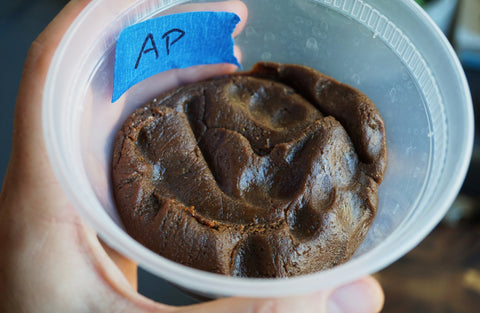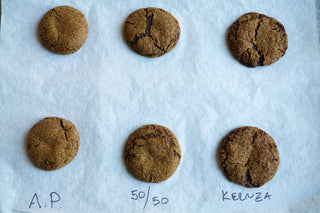Looking for the recipe? Here is the Chewy Molasses Kernza Cookies recipe we used in this article.
We recently had a comment asking about the potential for substituting Kernza in a recipe (more specifically a cookie recipe) that calls for all purpose flour. Though our experience with Kernza flour has revealed properties quite different than refined or all purpose flour, we decided to test exactly how much you can get away with when subbing in Kernza. Hopefully this narrows down some of the guesswork involved in getting started with our flour. This one’s for you, Lane!
This molasses cookie recipe from Bon Appetit makes delicious, chewy and fluffy molasses cookies. Their texture, rise, and overall appearance make them a great control for our experiment. You can find the winning version of the recipe in our Chewy Molasses Kernza Cookies recipe post.
The Experiment
We made three batches of cookies: Our control was Bon Appetit’s recipe, unchanged, using 100% all purpose flour. The second batch comprised of equal portions by volume of Kernza and A.P., and the final batch was made entirely with Kernza. Each of these doughs were baked twice; once while they were at room temperature, and once after they had a chance to cool in the fridge for twenty minutes.
Differences started to arise as early as the mixing phase; The dough changed from light and smooth (100% A.P.) to somewhat dense and coarse (100% Kernza). The 50/50 dough was somewhere in the middle (makes sense). 



The first bake was done immediately after mixing, while the dough was at room temperature, and the results were somewhat expected. As you can see in the photos, the A.P. cookies had a good rise, and a nice chewy, fluffy texture on the inside. As more Kernza was introduced, these characteristics diminished. The 100% Kernza cookies were fairly flat, a little dense, and the texture from the bran was very apparent. However, the 50/50 batch turned out better than expected; there was a drop in the rise, but the inside texture remained pleasant and not too dense. Adding to this, the flavor difference was significantly more enjoyable when Kernza was included. It seemed to balance out each of the spices while contributing its own flavor.
Results

Results: All-Purpose Flour


Results: 50/50 All-Purpose/Kernza


Results: 100% Kernza


Once the dough had a chance to cool, another batch of cookies were made. This time, the change in characteristics were much less noticeable; the cool dough was able to maintain more of its structure in the oven causing less of a flattening effect amongst the Kernza cookies.




The Takeaway
As one would expect, the shape and texture of these cookies were negatively affected by the addition of Kernza. On the other hand, the flavor showed a drastic improvement when Kernza was added to the mix. When baked cold from the fridge, the 50/50 dough was determined to be the best over all: The cookie rose significantly, the middle remained soft and somewhat light, and the flavor was unmatched.
This is only one recipe, but the results should correlate to innumerable baked goods. To better your odds, try starting with a 20% substitution when working with all purpose flour. The flavor will still come through! Additionally, should you prefer an even softer texture, try sifting out some of the bran before mixing the flour into the dough. We hope this helps! Be sure to try this recipe with Kernza and let us know what you think! You can find the resulting recipe here.

